INTRODUCTION TO JAPAN
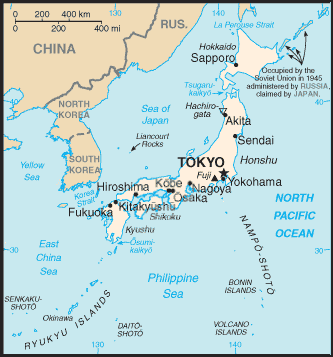
Japan's appeal lies in its beauty, traditions, and especially its oddities and contradictions (in the eyes of Westerners anyway). Potato chips are flavored with fish; soda pop is made with milk; people wash themselves before stepping into a bath; and monks make six-figure incomes and race around in BMWs and live in comfortable homes with their wife and kids.
Of course there are plenty of wonderful places to visit: bucolic fishing villages, unchanged over the centuries; gardens that look as if they were constructed by gods; 1,000-year-old wooden temples dedicated to tree spirits and flying squirrels; hot springs surrounded by rice terraces and smoking volcanos; and national parks with pine tree forests, snowcapped peaks, wandering hermits, snow monkeys, land crabs and foot-long blue worms.
But what makes visiting Japan such extraordinary experience is the way everything is familiar but somehow also turned on its head. People work in offices, but the building rest on earthquake-proof hydraulic shock absorbers. After work they can enjoy a beer or a Scotch but they don’t have to a bar to it the can purchase on the streets (along with used panties, beetles and pornography) from vending machines that always work. At home on television, they can watch sumo wrestlers and baseball players do karaoke versions of the latest hit songs and young women apologize for having nice bodies.
For recreation and fun the Japanese go snowboarding on huge, refrigerated indoor ski slopes, fish for pink bioluminescent squids, parade around half naked with massive decorated religious shrines on the shoulders, eat green-tea-flavored Haagen Daz and go horseback riding on a mechanical horses placed in front of projection screen showing English countryside.
Yes, Japan is a trip. The only problem with it though, from a traveler's point of view, is that it can be so expensive. Hotel room rates start at US$200, movies cost US$20 and a taxi ride from the airport to downtown Tokyo can be as much as a US$175. But if you are willing to make some sacrifices, such as staying in hostels or small business hotels, getting a rail pass, and buying food from supermarkets, street vendors and cheap but good restaurants, you can have good time in Japan without bankrupting yourself.
GEOGRAPHY OF JAPAN
With the Pacific Ocean to the east, the Sea of Japan to the west and the East China Sea to the south, Japan is an archipelago comprised of four major island and 6,800 smaller islands. Covering about 145,856 square miles (370,000 square kilometers), Japan is slightly larger than the United Kingdom, slightly smaller than California and one twenty-fifth the size of the United States. The nearest countries are Korea (about 100 miles to the west), Russia and China.
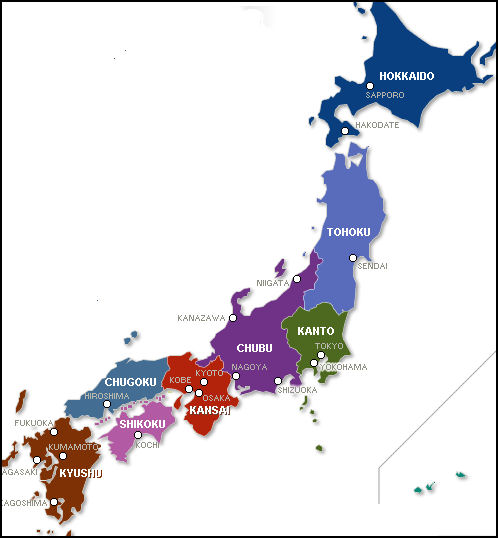
regions of Japan
The islands of Japan make up less than 15 percent of Japan’s total territory. Most of its territory is in the sea. In addition to the 200 nautical miles (370 kilometers) of ocean that Japan claims around the main islands according to the 1982 United Nations Convention of the Law of the Sea, Japan also claims 200 nautical miles around far flung islands that extend from near Taiwan and China to far out in the Pacific Ocean.
About 12.7 percent of the country is good for agriculture (compared to 21 percent in the U.S.) and most of this arable land is along the coast or in the river valleys between the mountains on the main islands. Mountain ranges and volcanos (some still very active) cover about 68 percent of Japan. Only 1.7 percent of Japan is covered by pastures and grasslands.
Most Japanese live in the sprawling urban areas that seem to go on forever, but once they end they give way to beautiful countryside. Forests cover about two-thirds of Japan. About 41 percent of the trees in the forest have been planted in nice neat rows, and 44 percent of the planted tree are cedars.
The islands of Japan are arranged in a bow-like formation. Four main islands account for 90 percent of Japan's land area. The four major islands of Japan are: 87,800-square-mile Honshu, or the "mainland," where Tokyo, Osaka and Kyoto are found; 30,150-square-mile Hokkaido, the northernmost of the large islands; 14,100-square-mile Kyushu, the volcanically-active southernmost large island; and 7,050-square-mile Shikoku, a rustic island on the Inland Sea between Honshu and Kyushu.
East Japan refers mainly to the Tokyo-Yokohama, Mount Fuji, Japan Alps area. West Japan refers to everything west and south of Kyoto and Osaka on Honshu, plus the northern part of Kyushu. The area around Tokyo is called Kanto (a reference to Kanto Plain which Tokyo is part of); the region that embraces Osaka, Kyoto and Kobe is called Kansai (or Kinki). Tohuko describes northern Honshu.

prefectures of Japan
Beginning about 250 mile south of Kyushu are the Ryukyu islands, which include Okinawa. North of Hokkaido are a few islands than run up to the Sakhalin islands, which Japan is currently trying to get back from Russia. Japan is divided into state-like 47 prefectures. The main mountain range, the Japanese Alps, is south of Tokyo.
Japan heavily indented coastline extends for 16,654 miles (about 28,000 kilometers) and consists of alternating stretches of rocky shore and beach, with protected bays, marshes and mud flats here and there. Around cities and towns the coastal areas are highly developed. There are not many nice beaches near the cities. The nicest ones are in remote places. Many places have been reclaimed from the sea.
Rivers: There are 32,000 rivers, streams and lakes. Because Japan is so mountainous it doesn't really have any navigable rivers except near the seas. Major Cities (estimated 2004); Tokyo, capital, 28.5 million; Osaka, 11 million; Nagoya, 3.2 million; Kyoto 1.8 million; Sapporo, 1.8 million.
CLIMATE OF JAPAN
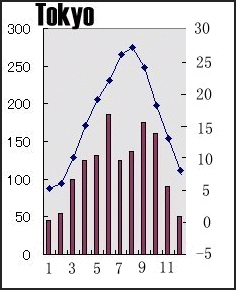
temperature and
precipitation by month Most of Japan has four distinct seasons, which are somewhat similar to those in the United States, and climate is generally mild thanks to the tempering effect of the ocean. But because the islands of Japan stretch 1,400 miles from north to south there are great variations, ranging from tropical in Okinawa (with the same latitude with Key West, Florida) to blustery and snowy in Hokkaido (with the same latitude as Quebec).
Springs is ushered in by plum blossoms in March and cherry blossoms in April, and is pleasant and sometimes rainy. Autumn begins in September and is characterized by falling leaves, crisp, cool, days and rice harvests. Northern Japan have pretty autumn colors.
Winter tends to be mild on the Pacific side, with many sunny days, while the Japan Sea side tends to be colder and more overcast. Winter in Hokkaido is shaped by frigid northwest winds from Siberia, which occasionally sweep across from the Asian continent bringing snow to coastal regions facing the Sea of Japan and to the central mountain regions. Hokkaido, northern Honshu and mountains in the interior of Honshu are some of the snowiest places on earth.
Summer can be very muggy, hot and humid, especially in August and September. In many places they say it is so humid in the summer that you can walk and swim at the same time and so hot you can fry rice on the sidewalk. It is not usual for swimmers have to wait in line for an hour to get a ticket for a 20 minute dip in a local swimming pool. Southeast winds blow across Japan from the Pacific in the summer bring rain to coastal regions facing the Pacific.
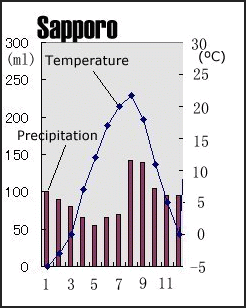
The humid rainy season lasts for about a month, from mid-June to mid-July in most parts of the country. But because Japan is strung out over such a large area latitude-wise the rainy season ends in Okinawa in June around the time it in starts Hokkaido and northern Japan. On most days of rainy season it rains for one two hours or less. The temperatures are significantly cooler than later in the summer.
The typhoon season lasts from late summer to early autumn. Most typhoons that strike Japan arrive in September and generally come ashore in southern Japan and dissipate as they move north. A summer heat wave sets in after the June rainy season is over In many places it is very hot with little relief many days in a row.
It is a good idea to bring along a fold up umbrella. It rains a lot in Japan and rain often starts unexpectedly. If you don't have an umbrella you can often buy a cheap one on the streets or in a convenience store or small shop.
Weather Web Sites :Japan Meteorological Agency Japan Meteorological Agency Weather Channel Weather Channel ;World Climate World Climate ; Accuweather Accuweather
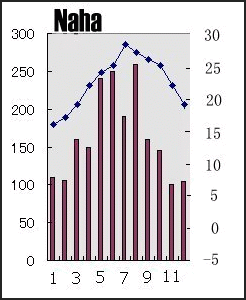
Best Times to Visit are in the autumn and spring. The winters are cold and the summers can be hot and humid. Plane fares to and from Japan are very high in the summer.
Clothing: Japanese are tolerant people and almost any clothing style is acceptable. Some Japanese dress smartly and fashionably. Others dress in jeans and shorts and shabby clothes.
Women in shorts skirts, jeans or tights and men in short pants and informal clothes are acceptable in most situations. Tourist often wear shorts and informal clothes. Keep in mind however that shorts, exposed shoulders and short skirts may be regarded unacceptable in some temples and shrines.
In hot weather, wear loose cotton garments. Don’t wear synthetic fabrics; they can be hot and scratchy. White or light-colored garments are better than dark ones. Wear a hat and sunglasses and use sun screen for protection from the sun. Sandals are often more comfortable than shoes and easier to slip on and off when entering temples.
Bring a jacket if you are traveling in the spring or autumn Sometimes the weather is cool at night. Bring warm clothes if you are arriving in the winter. People planning to do any bicycling, hiking or traveling in the rainy weather are advised to bring long underwear, fleece outer garments and rain gear, preferably made with Gortex. Layers of clothing is recommended in the spring and autumn to adapt to temperature changes throughout the day.
PEOPLE OF JAPAN
Japan is home to 127.7 million people and its population density is 13 times higher that of the United States (the equivalent of half the population of the entire United States living in California) and what makes this statistic even more remarkable is that more than four fifths of Japan is covered by mountains.
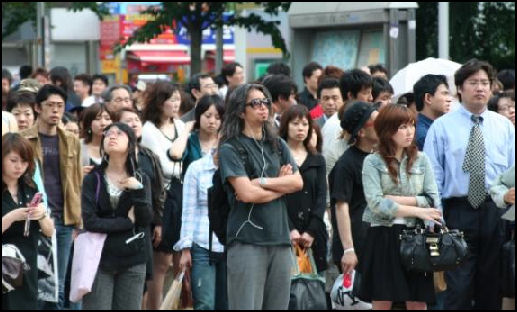
More than 77 percent of all Japanese live in urban areas (almost the same as the United States), with half of urban dwellers residing in four metropolitan areas in and around Tokyo, Osaka, Nagoya and Kitakyushu. The population began shrinking slightly in 2004. The average life expectancy is 77 for men and 82 for women (the highest in the world); and about 17.3 percent of all Japanese are under 15, and 17.3 percent are over 60.
The Japanese pride themselves on the racial harmony of their people. This means there are not many ethnic groups in Japan that aren't Japanese and most non-Japanese are not Japanese citizens. Even some ethnic Koreans, who don't speak Korean and whose families have lived in Japan for four generations, are not Japanese citizens. The largest indigenous minority are Ainu, a small tribe of people in northern Japan that is in danger of becoming extinct. About 99.5 percent of the population is Japanese, 0.5 percent are Korean, and 0.1 percent are Chinese. Only a few thousand pure blood Ainu are left.
JAPANESE LANGUAGE
Japanese is the official language. English is taught in schools from the 7th grade onwards but most Japanese are a little more shy and hesitant about speaking it with foreigners than people in some other Asian countries. Most train stations, tourist information offices and department stores employ someone who speaks English. Train signs and many road signs are in English as well as Japanese.
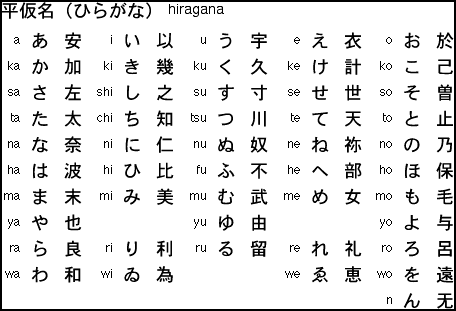
Japanese is a polysyllabic, highly inflected language but is not a tonal language like Chinese, with words that change meaning depending on the tone or pitch in which it is spoken. Japanese is grouped in the Altaic group of languages which includes Korean, Mongolian and Turkish but not Chinese.
Japanese is considered one of the world's most difficult languages to learn. Once described as the "greatest barrier to human communication ever devised," it has a word order that is difficult for Westerners to master; information is often is exchanged in indirect ways rather than direct ways; and separate sets of words are used when speaking to friends, people of higher status and people of lower status.

People need to know three alphabets to read a newspaper in Japan. The difficult-to-master Japanese writing system consists of two phonetic alphabets — 51-letter “hiragana” (for Japanese words) and 51-letter “katakana” (mostly for foreign words) — and Chinese characters known as “kanji”. Most Japanese understand around 2,000 kanji characters. Educated Chinese, by contrast, can read about 5,000 characters.
RELIGION IN JAPAN
Japan is intrinsically not a very religious place. Religion practices are viewed more as duties, traditions and customs rather than something with spiritual meaning to the person who practice them. Japanese worship both Buddhist and Shinto deities as well as their ancestors spirits in hope of pacifying everyone and thus ensuring good fortune. Confucianism (a philosophy incorporating ancestor worship) has been incorporated into the social and ethical code.

features of a Shinto shrine
Shintoism, meaning the "way of the Gods," is an informal animist, nature-worshiping religion that honors ancestors, pays tribute to “kamis”, or spirits, and has traditionally has had strong bonds with the Japanese state, emperor and culture. There are literally millions of kamis, most of whom are associated with the heavens or natural objects on earth such as trees and mountains. One of the most important deities is Amaterasu-omikami, the sun goddess, who, according to legend, is an ancestor of the Japanese Emperor.
Most Japanese practice some form of both Buddhism and Shintoism but few are devout followers of either. According to one count, Shintoism has 107 million followers (85 percent of the population) and Buddhism has around 93 million followers (75 percent). There about 1.4 million Christians (less than one percent of the population) and they are divided more or less equally among Catholics and Protestants. There are also many religious cults. Many have links to Buddhism and some have several million members.

features of a Buddhist pagoda
Many Japanese homes have two alters: one Shinto and one Buddhist. The faithful make daily offerings of rice cakes, salt and holy water which are laid on top of the alters, often decorated with the pictures of deceased relatives. There is a saying that Japanese come into the world as Shintos and go out as Buddhists: funerals are usually observed with Buddhist rites while births and marriages are celebrated with Shinto ceremonies.
Image Sources: 1) CIA factbooks 2) 10) 11) JNTO 3) Wikipedia 4) Tokyo Pictures 5) 6) 7) June from Goods from Japan
Text Sources: New York Times, Washington Post, Los Angeles Times, Daily Yomiuri, Times of London, Japan National Tourist Organization (JNTO), National Geographic, The New Yorker, Time, Newsweek, Reuters, AP, Lonely Planet Guides, Compton’s Encyclopedia and various books and other publications.
